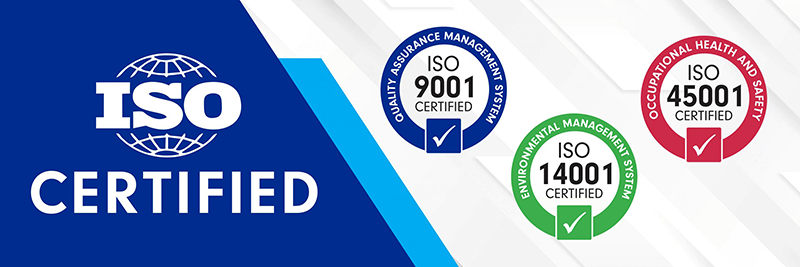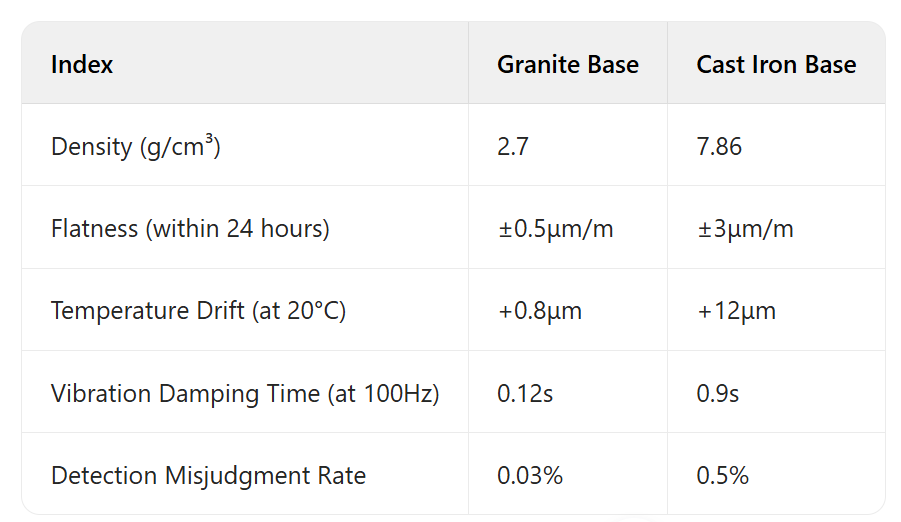In the field of precision manufacturing, the common misconception is that "higher density = stronger rigidity = higher precision". The granite base, with a density of 2.6-2.8g/cm³ (7.86g/cm³ for cast iron), has achieved a precision surpassing that of micrometers or even nanometers. Behind this "counter-intuitive" phenomenon lies the deep synergy of mineralogy, mechanics and processing techniques. The following analyzes its scientific principles from four major dimensions.
1. Density ≠ Rigidity: The decisive role of material structure
The "natural honeycomb" crystal structure of granite
Granite is composed of mineral crystals such as quartz (SiO₂) and feldspar (KAlSi₃O₈), which are closely bonded by ionic/covalent bonds, forming an interlocking honeycomb-like structure. This structure endows it with unique attributes:
The compressive strength is comparable to that of cast iron: reaching 100-200 mpa (100-250 mpa for gray cast iron), but the elastic modulus is lower (70-100 gpa vs 160-200 gpa for cast iron), which means it is less likely to undergo plastic deformation under force.
Natural release of internal stress: Granite has undergone aging over hundreds of millions of years of geological processes, and the internal residual stress approaches zero. When cast iron is cooled (with a cooling rate > 50℃/s), internal stress as high as 50-100 mpa is generated, which needs to be eliminated by artificial annealing. If the treatment is not thorough, it is prone to deformation during long-term use.
2. The "multi-defect" metal structure of cast iron
Cast iron is an iron-carbon alloy, and it has defects such as flake graphite, pores and shrinkage porosity inside.
Graphite fragmentation matrix: Flake graphite is equivalent to internal "microcracks", resulting in a 30%-50% reduction in the actual load-bearing area of cast iron. Although the compressive strength is high, the flexural strength is low (only 1/5-1/10 of the compressive strength), and it is prone to cracking due to local stress concentration.
High density but uneven mass distribution: Cast iron contains 2% to 4% carbon. During casting, carbon element segregation can cause density fluctuations of ±3%, while granite has a mineral distribution uniformity of over 95%, ensuring structural stability.
Second, the precision advantage of low density: dual suppression of heat and vibration
The "inherent advantage" of thermal deformation control
The coefficient of thermal expansion varies greatly: granite is 0.6-5×10⁻⁶/℃, while cast iron is 10-12×10⁻⁶/℃. Take the 10-meter base as an example. When the temperature changes by 10℃ :
Granite expansion and contraction: 0.06-0.5mm
Cast iron expansion and contraction: 1-1.2mm
This difference makes granite almost "zero deformation" in a precisely temperature-controlled environment (such as ±0.5℃ in a semiconductor workshop), while cast iron requires an additional thermal compensation system.
Thermal conductivity difference: The thermal conductivity of granite is 2-3W/(m · K), which is only 1/20-1/30 of that of cast iron (50-80W/(m · K)). In equipment heating scenarios (such as when the motor temperature reaches 60℃), the surface temperature gradient of granite is less than 0.5℃/m, while that of cast iron can reach 5-8℃/m, resulting in uneven local expansion and affecting the straightness of the guide rail.
2. The "natural damping" effect of vibration suppression
Internal grain boundary energy dissipation mechanism: The micro-fractures and grain boundary slippage between granite crystals can rapidly dissipate vibration energy, with a damping ratio of 0.3-0.5 (while for cast iron it is only 0.05-0.1). The experiment shows that at a vibration of 100Hz:
It takes 0.1 seconds for the amplitude of granite to decay to 10%
Cast iron takes 0.8 seconds
This difference enables granite to stabilize instantly in high-speed moving equipment (such as the 2m/s scanning of the coating head), avoiding the defect of "vibration marks".
The reverse effect of inertial mass: Low density means that the mass is smaller in the same volume, and the inertial force (F=ma) and momentum (p=mv) of the moving part are lower. For instance, when a 10-meter granite gantry frame (weighing 12 tons) is accelerated to 1.5G compared to a cast iron frame (20 tons), the driving force requirement is reduced by 40%, the start-stop impact is decreased, and the positioning accuracy is further improved.

Iii. Breakthrough in "density-independent" precision of processing technology
1. Adaptability to ultra-precision processing
"Crystal-level" control of grinding and polishing: Although the hardness of granite (6-7 on the Mohs scale) is higher than that of cast iron (4-5 on the Mohs scale), its mineral structure is uniform and can be atomically removed through diamond abrasive + magnetorheological polishing (single polishing thickness < 10nm), and the surface roughness Ra can reach 0.02μm (mirror level). However, due to the presence of graphite soft particles in cast iron, the "furplough effect" is prone to occur during grinding, and the surface roughness is difficult to be lower than Ra 0.8μm.
The "low stress" advantage of CNC machining: When processing granite, the cutting force is only 1/3 of that of cast iron (due to its low density and small elastic modulus), allowing for higher rotational speeds (100,000 revolutions per minute) and feed rates (5000mm/min), reducing tool wear and enhancing processing efficiency. A certain five-axis machining case shows that the processing time of granite guide rail grooves is 25% shorter than that of cast iron, while the accuracy is improved to ±2μm.
2. Differences in the "cumulative effect" of assembly errors
The chain reaction of reduced component weight: Components such as motors and guide rails paired with low-density bases can be simultaneously lightened. For instance, when the power of a linear motor is reduced by 30%, its heat generation and vibration also decrease accordingly, forming a positive cycle of "improved precision - reduced energy consumption".
Long-term precision retention: The corrosion resistance of granite is 15 times that of cast iron (quartz is resistant to acid and alkali erosion). In a semiconductor acid mist environment, the surface roughness change after 10 years of use is less than 0.02μm, while cast iron needs to be ground and repaired every year, with a cumulative error of ±20μm.
Iv. Industrial Evidence: The Best Example of Low Density ≠ Low Performance
Semiconductor testing equipment
Comparison data of a certain wafer inspection platform:
2. Precision optical instruments
The infrared detector bracket of NASA's James Webb Telescope is made of granite. It is precisely by taking advantage of its low density (reducing satellite payload) and low thermal expansion (stable at ultra-low temperatures of -270℃) that nano-level optical alignment accuracy is ensured, while the risk of cast iron becoming brittle at low temperatures is eliminated.
Conclusion: "Counter-common sense" innovation in materials science
The precision advantage of granite bases essentially lies in the material logic victory of "structural uniformity > density, thermal shock stability > simple rigidity". Not only has its low density not become a weak point, but it has also achieved a leap in precision through measures such as reducing inertia, optimizing thermal control, and adapting to ultra-precision processing. This phenomenon reveals the core law of precision manufacturing: material properties are a comprehensive balance of multi-dimensional parameters rather than a simple accumulation of single indicators. With the development of nanotechnology and green manufacturing, low-density and high-performance granite materials are redefining the industrial perception of "heavy" and "light", "rigid" and "flexible", opening up new paths for high-end manufacturing.
Post time: May-19-2025



